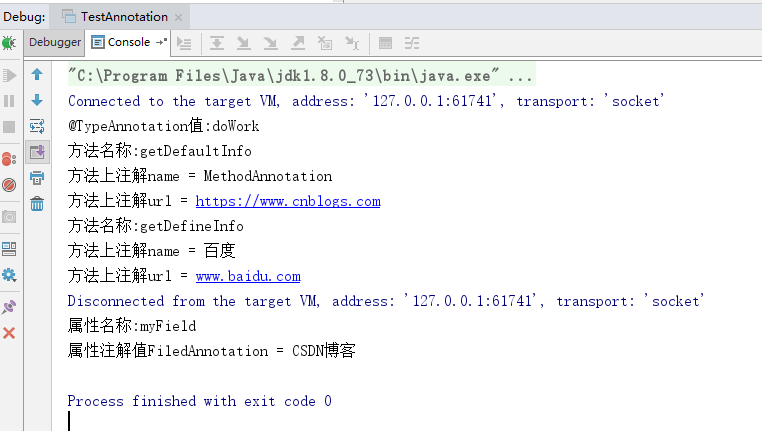场景:为了理解@interface使用
1.@interface自定义注解
<1>@interface自定义注解自动继承了java.lang.annotation.Annotation接口,由编译程序自动完成其他细节。
<2>在定义注解时,不能继承其他的注解或接口。
<3>使用@interface来声明一个注解,
1>.每一个方法实际上是声明了一个配置参数,
2>.方法的名称就是参数的名称,
3>.返回值类型就是参数的类型,(返回值类型只能是基本类型、Class、String、enum)
4>.可以通过default来声明参数的默认值
2.举例说明,分别作用在类,方法,属性上的注解
<1>.作用在属性上注解
@Documented @Retention(RetentionPolicy.RUNTIME) @Target(ElementType.FIELD) public @interface FiledAnnotation { String value() default "GetFiledAnnotation"; }
<2>.作用在方法上注解
@Documented @Retention(RetentionPolicy.RUNTIME) @Target(ElementType.METHOD) public @interface MethodAnnotation { String name() default "MethodAnnotation"; String url() default "https://www.cnblogs.com"; }
<3>.作用在类上注解
@Documented @Retention(RetentionPolicy.RUNTIME) @Target(ElementType.TYPE) public @interface TypeAnnotation { String value() default "TypeAnnotation"; }
<4>.使用自定义注解
@TypeAnnotation("doWork")
public class Worker {
@FiledAnnotation("博客园")
private String myField = "";
@MethodAnnotation
public String getDefaultInfo() {
return "do the getDefaultInfo method";
}
@MethodAnnotation(name = "百度", url = "www.baidu.com")
public String getDefineInfo() {
return "do the getDefineInfo method";
}
}
<5>.测试自定义注解
public class TestAnnotation { public static void main(String[] args) throws ClassNotFoundException { Class cls = Class.forName("com.liuqing.annotation.Worker"); Method[] method = cls.getMethods(); /**判断Worker类上是否有TypeAnnotation注解*/ boolean flag = cls.isAnnotationPresent(TypeAnnotation.class); /**获取Worker类上是TypeAnnotation注解值*/ if (flag) { TypeAnnotation typeAnno = (TypeAnnotation) cls.getAnnotation(TypeAnnotation.class); System.out.println("@TypeAnnotation值:" + typeAnno.value()); } /**方法上注解*/ List<Method> list = new ArrayList<Method>(); for (int i = 0; i < method.length; i++) { list.add(method[i]); } for (Method m : list) { MethodAnnotation methodAnno = m.getAnnotation(MethodAnnotation.class); if (methodAnno == null) continue; System.out.println("方法名称:" + m.getName()); System.out.println("方法上注解name = " + methodAnno.name()); System.out.println("方法上注解url = " + methodAnno.url()); } /**属性上注解*/ List<Field> fieldList = new ArrayList<Field>(); for (Field f : cls.getDeclaredFields()) {// 访问所有字段 FiledAnnotation filedAno = f.getAnnotation(FiledAnnotation.class); System.out.println("属性名称:" + f.getName()); System.out.println("属性注解值FiledAnnotation = " + filedAno.value()); } } }
打印结果
